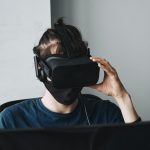The past 5 years has been an exciting and promising time in VR’s evolution. With numerous multinational companies choosing to switch their workplace training to VR, the technology is now integrated into just about every industry. From big-box retail, to health care, construction, food production, policing and more. VR has gained recognition as a highly interactive and versatile workplace training tool.
Defining VR Training
VR makes escaping into a new world possible as one shifts from a 2D environment to the 3D immersive landscape that is Virtual Reality. In the workplace, VR training enables employees to view a set of uniquely tailored learning modules, through a wireless goggle-like headset. Modules are curated using VR, data science, proven teaching methods and spatial design, allowing employees to experience a modern method of learning, known as “Immersive Learning.”
Through immersive learning, employees are presented with industry-specific scenarios to prepare them for any situation. Even the most dangerous or life-threatening scenarios that would be impossible to be practiced in the real world, can be accessed through VR. However VR training isn’t just exclusive to safety hazards and compliance measures, hence why CEOs from diverse industries are embracing the benefits of this technology.
Why CEOs Are Making The Switch To VR
Broadening Employee Knowledge & Expertise
As CEOs seek to to sharpen their employees’ knowledge and customer service skills, VR aims to individualise training to improve business efficiency and productivity. VR’s video and audio simulation enables enclosed learning that is often viewed as more interesting as well as faster to retain knowledge. Studies have revealed learning through media systems, as opposed to learning in a physical environment, heightens a user’s engagement as it involves the simulation of more than one of the five senses simultaneously.
A 2016 study on airplane emergency landing using VR versus traditional methods found that digital methods of learning were far more effective compared with traditional methods such as printed materials, videos and oral briefing. Of the study’s 48 participants, half were required to take training using card pictorials, whilst the other half through VR serious gaming. The results found that serious gaming took an average of just four minutes for all but two users to fully grasp the knowledge presented. Users also improved their attitude and sense of control when dealing with emergency landings.
Needless to say, in the long-term, having such a strong understanding about safety compliance measures is crucial as it has other significant benefits for a business. Major areas that are likely to benefit from VR training are increased staff retention rates and reduced expenses for preventory situations such as staff turnover and workplace injuries.
Tracking Progress and Performance
CEO’s also prioritise being able to consistently provide ongoing training to new and existing employees, as improving the customer experience has a measurable impact on business performance. However, preparing long and tedious powerpoint presentations or hosting an after-hours in person training session can be highly time-consuming. VR training can be conducted without the need for assistance or monitoring, allowing employees one hundred percent independence when processing content.
A PwC study undertaken by a group of new managers in 12 US locations, found that learning was 4x faster using VR headsets than in classroom style settings. Coupled with faster learning time, is VR’s excellent integration of data analytics, whereby CEO’s are able to track the progress of each of their employee’s performance. This is an invaluable resource as through performance metrics analysis a deeper understanding on what each employee’s strengths and weaknesses are will be indicated, in conjunction with particular areas that may need additional training.
How are Employees responding to VR Training?
Fully Immersed
Virtual Reality fits into the realm of ‘spatial presence’ as users experience media stimuli in such a way as if it were real, creating a sense of presence in a computer-mediated environment. According to Hartmann, Wirth and Vorderer, attention is a key component to spatial presence as “it may direct the users sensory perception to mediated stimuli and away from cues provided by the real environment.” PwC study supports this claim, as results found participants were 4x more focused using VR than e-learning peers, and felt 375% more connected to content. VR provides a solution that aligns engaging workplace training in a distraction-free space, so that absorbing new knowledge no longer has to feel forced.
Real Life Application
VR maximises knowledge retention through providing accurate and provoking situations in the form of audio and visual simulation, which have been proven to remain in the users memory recall well after training is completed. Studies have shown the impact of virtual reality upon human emotions and how it has helped participants to reduce fear whilst increase their ability to handle high-pressure situations. As training modules often include a range of strategies targeted to specific workplace scenarios, employees sense of achievement to overcome challenges is highly valued through VR. VR training offers employees a space to make mistakes so that they can enter the workplace each day with reassurance and confidence to handle familiar challenges in the real world.
Although VR training is still considered to be new to corporations, employees are already embracing VR with open arms and CEO’s are acknowledging the variety of interactive uses the technology has to improve both staff retention and performance. Where traditional training methods may have been slowing down the potential productivity of teams, VR training provides modern tools to build employees up to the top and create a staple, long-term solution.
Written by Lauren Tizzone
Similar articles to check out:







